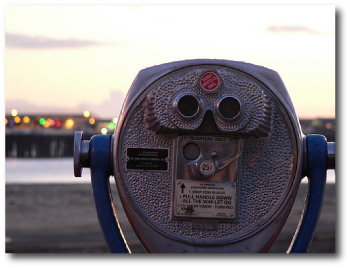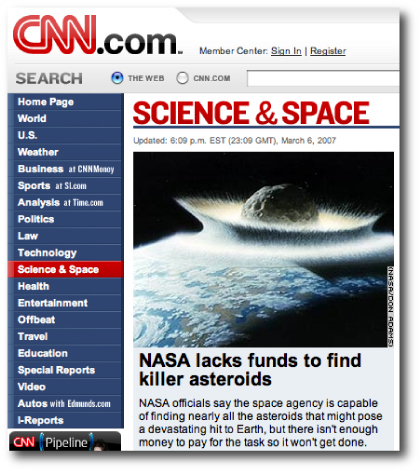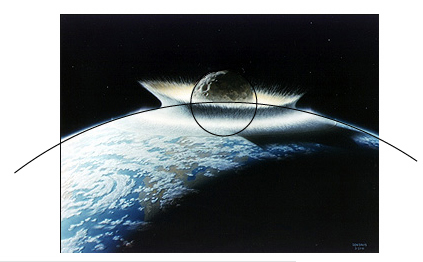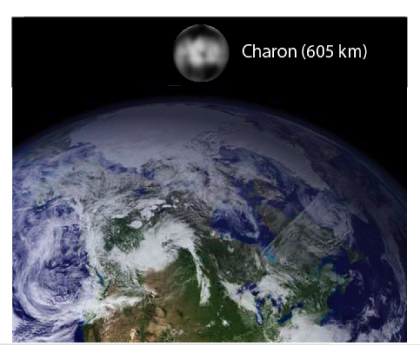
Image Source.
The news out of the Planetary Defense Conference is that NASA has the ability to locate all the potentially dangerous asteroids in our solar system by the year 2020, but that the cash to carry out the project is not currently forthcoming.
CNN and many other news outlets carried the story, along with a dramatic artist’s rendition of an asteroid striking the Earth.

That’s a rather large asteroid.

Measuring the circumscribed circles, it appears that the impacting body is 1/10th the Earth’s diameter, or approximately 600 km in radius. A bolide of this magnitude would currently rank as the ~25th largest object in the solar system, larger than Uranus’s moon Umbriel (584 km radius), smaller than Saturn’s moon Iapetus (736 km in radius), and nearly exactly the same size as Pluto’s moon Charon (606 km in radius). Ceres, the largest object in the main asteroid belt, by contrast, has a radius of ~475 km.

Based on the location of the late-afternoon catastrophe relative to the day-night terminator, the impactor seems to have had an orbit that was highly inclined relative to the solar system’s angular momentum plane. Perhaps it was undergoing Jupiter-driven Kozai oscillations prior to striking the Earth.
The last impact of the magnitude shown in the illustration was probably the Moon-forming impact ~4.4 Billion years ago, in which a Mars-sized body struck the Earth. Kevin Zahnle of the NASA Ames Research Center has estimated the distribution of giant impacts after the Moon-forming event. It’s likely that the largest strikes were by bodies with roughly half the radius of the object shown in the above picture.
The consequences of even a 300 km object hitting the Earth are severe. Such an impact is energetic enough to entirely vaporize the Earth’s oceans and create a temporary rock-vapor atmosphere with a surface pressure of ~100 bars. For a period of several months to a few years, the Earth would radiate with a temperature of ~2000 Kelvin — hot enough to glow brightly in the visible region of the spectrum. And depressingly, our planet would be fully sterilized by the event.

The bigger they are more money they get to keep on with their jobs on the project… This one is scary enough.
Unfortunately, the news that we don’t have enough money to fund such a program as reported by CNN doesn’t surprise me at all. That’s been the story for many years when it comes to NEOs and NEAs. For years funding for programs searching for NEOs and NEAs has either not been allocated or has been cut once appropriated. Whole projects that were ready to go were cancelled at the last minute because of politics and lack of funding. And, what most people don’t realize is that only about a third of existing asteroids have been identified, and only from the northern hemisphere. Virtually no NEO searches have occurred in the southern hemisphere. I find it sad that we have hundreds of billions of dollars to make war and kill one another, but we don’t have enough funding for a project that not only would cost a minute fraction of what the Iraq war cost, but which could also ultimately save us from a global castastrophe of biblical proportions.
It is also disturbing to me the ignorance surrounding this issue with respect to the general public. How many people have even heard of the asteroid 99942 Apophis (2004 MN4) or things like the Torino or the Palermo Impact Hazard scales? Apophis is approximately the size of the Rose Bowl. But, even if it manages to impact the Earth on its second pass in 2036, as bad as the destruction would be it still is survivable. But an asteroid the size of Charon is indubitably a planet killer.
And the really sad thing about it all, is with enough warning, such a catastrophe is preventable. For example the B612 FOUNDATION organized by Piet Hut and astronaut Ed Lu at NASA Johnson Space Center proposes a gravity tractor to tweak the trajectory of an asteroid on a collision course with Earth. But, again the biggest problem they have is not an engineering one, but–and there’s that word again–FUNDING!
I’m sorry for rattling on so long about this. But this is one of several issues about which I feel very passionately.
I love your careful scrutiny of a piece of space art. Even if we saw that thing coming decades in advance, I doubt much could be done.
Let me question your conclusion that “…the impactor seems to have had an orbit that was highly inclined relative to the solar system’s angular momentum plane.”
This asteroid might not be striking the North polar region head-on, but rather at a glancing angle. The ejecta seems to give the appearance that it is coming from the top right. Most craters are round unless the impactor hits at a very shallow angle, so even with an angle of 45 degrees, I would imagine the ejecta would appear somewhat symmetrical, as it is in the image.
But even if it stuck the North Pole region head-on, it still doesn’t mean that it had a highly inclined solar orbit to begin with. If you stood on the Northernmost part of Earth with respect to the ecliptic (somewhere on the Arctic Circle), and launched a rocket straight up at 11,200 km/s, Earth escape velocity, it would only achieve a solar inclination of about 1.5 degrees. The asteriod hitting squarely is simply the reverse of this. Realistically, it would probably be hitting at a speed greater than escape velocity, so the inclination would probably be greater than ~1.5 degrees. But it needs an inclination of at least ~40 degrees for the Kozai mechanism to work.
regarding Eric’s comment: “and only from the northern hemisphere. Virtually no NEO searches have occurred in the southern hemisphere.”
I don’t think the lack of Southern Hemisphere observations is a big deal, since no asteroid can remain continuously below the ecliptic. Every asteroid will spend roughly half its time in the Northern sky. And most Northern Hemisphere observatories can see a lot of the southern sky.
Although I agree with you that cutting off funding is silly, let me play devil’s advocate for a minute. In the last 50 years, with only a minimal amount of funding directly allocated to an asteroid protection program, we’ve gone from not even recognizing that a threat exists, to indentifying the threat, and finding roughly 1/3 of all the potentially hazardous asteroids. We’ve also developed the ability to travel to the asteroids. And we’ve proposed several viable methods of dealing with a threat. Not bad for 50 years. I would imagine that in the next one to two hundred years, with our without dedicated funding, we’ll have identified all the potential hazardous asteriods, mapped the Oort Cloud, recognizing cometary threats, and perfected our deflection methods. And the odds that Earth will get hit by something significant in the next 200 years are astronomically low. So even without dedicated funding, I’m optomistic that Earth will never again be hit by anything significant. That said, I do agree with you. We’ve spent more money making doomsday asteroid movies than we’ve spent actually addressing the real issue.
oops, I meant 11,200 m/s.
Hi Tony,
You’re correct in pointing out that gravitational focusing makes it unnecessary to require a high inclination angle for the impact.
It is true, however, that the body in the picture must have come from either (a now depleted) part of the main belt, or from the Kuiper belt. Presumably, the impact being shown in the illustration occurred during the late heavy bombardment ~3.8 billion years ago. For either reservoir of origin, the orbit would have had a high delta-v relative to the Earth, which increases the required inclination somewhat in order to have a high-angle impact onto the polar region.
Also, I guess there’s no reason to require that the image depicts a “north is up” orientation. If we relax that assumption, we could be looking at a strike occurring much closer to the equator…
best,
Greg